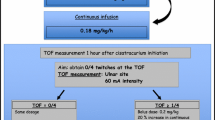Abstract
Objective
To investigate the infusion requirements and recovery characteristics of cisatracurium compared with atracurium when both are administered by prolonged continuous infusion.
Design
A prospective, randomised, single-blind study.
Settings
The Intensive Care Unit of the Manchester Royal Infirmary.
Patients
20 patients requiring a continuous infusion of a neuromuscular blocking agent to facilitate mechanical ventilation. 12 patients received cisatracurium and 8 received atracurium.
Interventions
Cisatracurium or atracurium was administered by continuous infusion for a minimum of 24h. The level of neuromuscular blockade was measured by recording the train-of-four responses using acceleromyography, the aim being to maintain 1–2 twitch responses of the adductor pollicis. At the end of the infusion period, the train-of-four was recorded until the ratio was greater than 0.7.
Measurements and results
The mean infusion rate of cisatracurium was 0.23 mgkg−1 h−1, compared to 0.62 mgkg−1 h−1. No time-related increase in infusion requirements was seen for either drug. The mean recovery time to a train-of-four ratio greater than 0.7 was the same (46 min). There was no correlation between recovery time and age, duration of infusion or mean infusion rate.
Conclusions
Cisatracurium provides a satisfactory level of neuromuscular blockade in adult ICU patients at approximately one-third the infusion rate of atracurium and with a similar recovery time.
Similar content being viewed by others
References
Hunter JM (1989) Neuromuscular blocking drugs in intensive therapy. Intensive Ther Clin Monit, 10: 147–152
Lien CA, Belmont MR, Abalos A, Abou-Donia M, Savarese JJ (1993) Dose response relations of 51W89 under nitrous-oxide-opioid-barbiturate anesthesia. Anesthesiology 73: 3A
Yate PM, Flynn PJ, Arnold RW, Weatherly BC, Simmonds RJ, Dopson T (1987) Clinical experience and plasma laudanosine concentrations during the infusion of atracurium in the intensive care unit. Br J Anaesth 59: 211–217
Wadon AJ, Dogra S, Anand S (1986) Atracurium infusion in the intensive care unit. Br J Anaesth 58: 64S-67S
Rowlands DE (1986) Atracurium in the elderly. Br J Anaesth 58: 39S
Boyd AH, Eastwood NB, Parker CJR, Hunter JM (1994) Pharmacodynamics of the single isomer of atracurium (51W89) in patients with or without renal failure. Br J Anaesth 72: 486P
Griffiths RB, Hunter JM, Jones RS (1986) Atracurium infusions in patients with renal failure on an ITU. Anaesthesia 41: 375–381
Sharpe MD (1992) The use of muscle relaxants in the intensive care unit. Can J Anaesth 39: 949–962
Slater RM, Pollard BJ, Doran BRH (1988) Prolonged neuromuscular blockade with vecuronium in renal failure. Anaesthesia 43: 250
Author information
Authors and Affiliations
Additional information
This work was completed with the support of a grant from the Wellcome Foundation ple
Rights and permissions
About this article
Cite this article
Pearson, A.J., Harper, N.J.N. & Pollard, B.J. The infusion requirements and recovery characteristics of cisatracurium or atracurium in intensive care patients. Intensive Care Med 22, 694–698 (1996). https://doi.org/10.1007/BF01709749
Received:
Accepted:
Issue Date:
DOI: https://doi.org/10.1007/BF01709749




